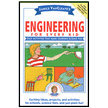Engineering projects may be part of a science fair, but each has a different set of guidelines for solving problems or finding answers to questions. The process for science fair projects is called the Scientific Method. The process used to develop an engineering fair project is called the Engineering Method. These different methods stem from the goals of these two different fields of study. The basic objective of science is to discover the composition and behavior of the physical world. The basic objective of engineering is to use scientific principles and methods to produce useful devices and services that serve mankind.
Now about developing a science fair engineering project for a specific grade level, the basic process is going to be the same no matter what grade you are in. The difference is in the complexity of the project. In addition to assistance from your teacher, you can determine the complexity required by researching engineering projects developed by other students at your grade level.
If I give you a step-by-step procedure for developing an engineering problem, then you would be presenting a copy of my work. This is much like purchasing a kit in which if you follow the directions and, voila! You have a project. Instead, I want to provide clues to help you develop your own project. While you may need help in securing materials as well as some of the constructions, you want to maintain ownership of the project. You want it to be your project–your ideas–your work.
How to Get Started!
If you have no idea for a project -Don’t panic.
If you have a basic idea for your project, don’t start developing it yet.
The first step and a very important one is to:
Research-Research-Research
The following question is a good place to start. The question links to an answer page, but don’t stop there. Check out other sources so that you have a clear understanding of what an engineering fair project is.
How are engineering fair projects judged?
Read about junior high engineering projects that have won prizes. This is not a suggestion to clone the ideas of others. Instead, it will reveal to you that you are not expected to design the next space shuttle. Reading about successful projects will also let you know that award winning engineering projects do not require expensive materials or equipment. I think you may discover that you have already designed and developed things and never recognized the process as being that of an engineer.
An example project: Garrett, a 7th grader who made a solar-powered air and water heater. Find out why some call him the “The Junk Yard Genius.”
I predict that after studying judging criteria and other engineering projects you will not only understand what is expected of you, but that you will have an idea for your own project. You might even read about a project and have an idea of how it could be improved. Is this acceptable? Absolutely! But your idea must actually improve the usefulness and not just be an aesthetic change, such as color. While color might make a big difference in mass marketing, more innovative changes are expected for your project. I’ll be looking forward to seeing more engineering fair projects as part of local, regional and national contests.
 |
Janice VanCleave’s Engineering for Every Kid: Easy Activities That Make Learning About Engineering Fun.Ideas that can be used to design engineering projects. |